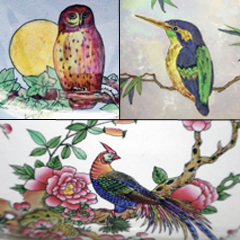Boulton's Birds - Part two

KINGFISHER, OWL,
& PHEASANT ROSE
By Enoch Boulton
by Harvey Pettitwith border artwork by Barbara Anne Lee
This is the second in a series of articles on patterns by Enoch Boulton featuring birds during his tenure as designer and decorating manager at the Carlton Works between 1921/22 and 1930.
As with the previous series of articles on Horace Wain's Chinoiserie patterns, Barbara Anne Lee's work on associated borders is featured.
The first article in this series was about Boulton's SWALLOW pattern, one of the 25-year-old's earliest patterns for his new employer. At the same time, two more bird patterns were introduced: KINGFISHER and OWL, shown below. These designs were also simpler, suited to the challenging economic times that followed the end of World War One. Labour shortages caused by the heavy loss of life during the conflict significantly affected the pottery industry. Boulton, who had fought in France, was fortunate to have survived; it was fortunate for us too, as he began to create highly original work unrelated to the past.

Right - OWL 2595 decorating the cover of a powder bowl.
To see these bowls fit your device's screen and/or enlarge it, click or tap them.
To return to this page use, your back button.
According to Carlton Ware's pattern records, KINGFISHER had twenty-two variants beginning with pattern number 2530, while OWL only had four, beginning with 2594.
The Carlton Ware Aviary
For two or three years, other birds avoided the Carlton Ware aviary until PHEASANT ROSE 2834 was introduced to the flock. Uncharacteristically for Boulton, the pattern was traditional in nature, reminiscent of Horace Wain, his predecessor. Notice, however, the bird is more exotic than might be expected from Wain.

By Enoch Boulton c.1924.
PHEASANT ROSE had fourteen variants beginning with pattern number 2832. It is related to another slightly later pattern, which you can read about in the article on CRETONNE.
The fowl's flamboyant feathers were to lead the way to more extravagant bird patterns. In the approaching second half of the 1920s, the fledgling designer's work was to make a distinctive mark on twentieth-century Staffordshire pottery and in the style that, from the late 1960s onwards, would be termed Art Deco.
Borders
Borders were not created for KINGFISHER, OWL, or PHEASANT ROSE. As a rule of thumb, none were used with them; a simple gold line sufficed. However, in pattern records, one variant of OWL (2604) specifies the use of SWALLOW BORDER, featured in the previous article and repeated below.
 Barbara Anne Lee 2024
Barbara Anne Lee 2024 Harvey
P.S. I dedicate this page to Veronica and David McIntosh because of their passion for Carlton Ware Kingfisher frogs.
V1a October 2024.
If more accurate information comes to light, I will update this page.
